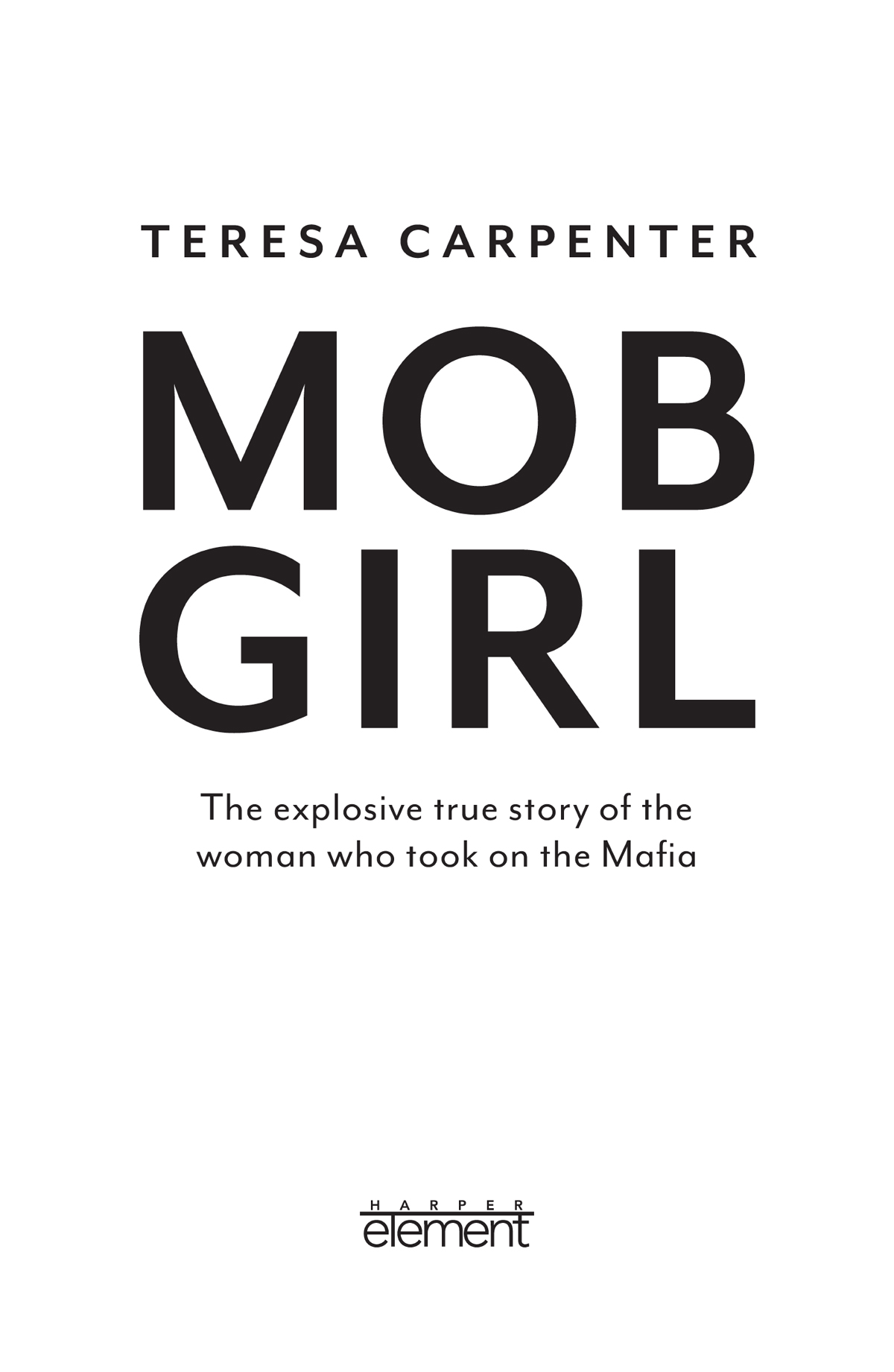
Mob Girl


COPYRIGHT
HarperElement
An imprint of HarperCollinsPublishers
1 London Bridge Street
London SE1 9GF
www.harpercollins.co.uk
First published in the US by Simon & Schuster 1992
This edition published 2020
FIRST EDITION
© Teresa Carpenter 2020
Cover design by Holly Macdonald © HarperCollinsPublishers Ltd 2020
Cover photograph © Elisabeth Ansley/Arcangel Images (posed by a model)
A catalogue record of this book is available from the British Library
Teresa Carpenter asserts the moral right to be identified as the author of this work
All rights reserved under International and Pan-American Copyright Conventions. By payment of the required fees, you have been granted the nonexclusive, non-transferable right to access and read the text of this e-book on screen. No part of this text may be reproduced, transmitted, downloaded, decompiled, reverse engineered, or stored in or introduced into any information storage retrieval system, in any form or by any means, whether electronic or mechanical, now known or hereinafter invented, without the express written permission of HarperCollins e-books.
Find out about HarperCollins and the environment at www.harpercollins.co.uk/green
Source ISBN: 9780008398699
Ebook Edition © July 2020 ISBN: 9780008398705
Version 2020-07-15
DEDICATION
For Leslie
AUTHOR’S NOTE
The people and events in this story are real. Conversations have been taken from surveillance transcripts or reconstructed by eyewitnesses to the events. Only the following names have been changed: Cousin Solly, Paulie Messina, Walter Perlmutter, Matthew Burton, Nathan Pincus, Tilly Palladino, “Beatrice,” “Jilly,” “Yvette,” “Nino” and members of the families Silverstein, Lamattina and Paterno. The name of Tommy Luca has been changed at the request of Arlyne Brickman because of her stated concern for her safety.
NOTE TO READERS
This ebook contains the following accessibility features which, if supported by your device, can be accessed via your ereader/accessibility settings:
Change of font size and line height
Change of background and font colours
Change of font
Change justification
Text to speech
Page numbers taken from the following print edition: ISBN 9780008398699
CONTENTS
Cover
Title Page
Copyright
Dedication
Author’s Note
Note to Readers
Introduction
PART ONE
1. House of Mirrors
2. Mob Girl
3. An Honest Woman
4. Wiseguys
5. Tommy
PART TWO
6. Fort Lee
7. Atlantic Beach
8. Forest Hills
9. Sweetie Pie
10. Witness
Epilogue: Fade Away
Bibliography
List of Searchable Terms
Acknowledgments
Other Books by Teresa Carpenter
About the Publisher
INTRODUCTION
When I arrived at Arlyne Brickman’s apartment one early afternoon, her drapes were drawn against the bright tropical sun, leaving the living room in a kind of perpetual twilight. Everything was perfect, as spotless and orderly as a nun’s chambers. The only evidence of habitation was a glass bookshelf on which rested three volumes: Wiseguy, Donnie Brasco and Mob Star. The kitchen was similarly austere except for an arrangement of purple chrysanthemums. I touched one and remarked, “They are beautiful!”
“Teresa,” Arlyne replied. “Don’t you know that old whores always have fresh flowers? It makes them feel clean.”
She was grinning.
When my buxom, red-headed hostess describes herself as a “whore,” she means it quite literally. For a time she worked as a call girl under the tutelage of a Manhattan madame. But on the occasion of our first meeting—July of 1988—I discerned that she also defines that self-inflicted barb in a more universal sense, meaning that she has lived a life oblivious to the tyranny of reputation. In the best and worst sense of the term, Arlyne Brickman is an outlaw.
The notorious Mrs. Brickman came to my attention earlier that summer when I began hearing tales of her adventures in the New York underworld. Not only was she a “Mafia princess,” being the daughter of a well-connected Jewish racketeer from the Lower East Side. Not only was she “married to the mob” by virtue of her carnal association with a string of wiseguys. Arlyne was racketeer in her own right, insinuating herself into the implacably male underworld, first as a courier of messages and then as the proprietor of a thriving bookmaking operation. Later, for reasons of fear, revenge and power, she turned informant. For over a decade she wore wires for New York and New Jersey police as well as federal agencies, including the FBI. Her surveillance of the Colombo Family led to the 1986 conviction of one of Carmine Persico’s top lieutenants.
Two years later, at the age of fifty-four, Arlyne decided it was time to immortalize her exploits in a book. Happily, she was not wed to the idea of a first-person account rendered through a ghostwriter. What she had in mind was an independent author who would be given a free hand to write a book about her. Arlyne, it turned out, had surprisingly sophisticated instincts about publishing, and realized that such an account would be more credible.
She first approached my husband, an investigative reporter and author who, after talking with her by phone, concluded her story was fascinating. “But,” he added turning to me, “this really seems more up your alley.” What he meant was that during my ten years as a crime reporter for the Village Voice, I made a career of studying bad girls. Specifically the kind who come from “good” homes and with middle-class expectations and somehow get rerouted into crime, prostitution and perversity. I’m sure there is an element of “there-but-for-the-grace of-God” in my interest. But that is not the whole story. I found myself admiring my own disreputable subjects. For the most part, they are women of considerable energy and enterprise. For all her apparent docility, Dorothy Stratten, the Playboy Playmate of the Year whose short life and tragic death I chronicled for the Voice in 1980, seemed impelled to make something of her life. The same thing could be said of Robin Benedict, the antiheroine of my previous book, Missing Beauty. Benedict strayed into the orbit of a pimp who perceived not only her beauty but also her energetic drive and turned her into a successful call girl. (Her enterprise had deadly consequences; Benedict was murdered by one of her johns, an eminent research biologist.) For a woman, however, the underworld often offers opportunities that the straight world does not.
Nowhere was that more apparent than in the case of Arlyne Brickman.
From the time she was twelve, Arlyne was driven by an almost fanatic ambition to become a mob girl. Although it is difficult, perhaps, to imagine how a child deliberately sets her sights on becoming a moll, it becomes easier if one understands the time and place in which the young Arlyne Weiss passed her formative years. The Lower East Side during the early part of the century was a precinct of a little over one square mile that was home to thousands of immigrants from Southern and Eastern Europe. For many young men from this teeming quarter, the pursuit of the American dream took the form of bookmaking, bootlegging and black-marketeering. The East Side, therefore, became a sanctuary for hoodlums and, ultimately, the birthplace of the mob—both Italian and Jewish. Arlyne’s father made his own fortune in the rackets during the thirties and forties, yet he craved respectability for his two daughters. The younger opted for the straight life. As the older, Arlyne had the opportunity to do the same, but she declined, preferring to follow the example of her maternal grandmother, the proprietress of an East Side funeral parlor. A woman of considerable charm and influence, the grandmother was also benefactress to a crew of racketeers who hung out in her cellar. She reveled openly in the “East Side Life,” tacitly encouraging her granddaughter to do the same.
Arlyne’s imagination was further piqued by the highly publicized exploits of Virginia Hill, the flamboyant red-headed girlfriend of Bugsy Siegel. During her heyday, Virginia refined and elevated the status of a gangster’s moll to that of national celebrity. One newspaper called her “the most successful woman in America.” It is small wonder that young Arlyne Weiss could imagine no calling more exalted than that of mob girl.
The job description was vague. A mob girl had to be good-looking, since a lot of her time was spent serving as a “showpiece” on a gangster’s arm. She had to be trustworthy, since she was often called upon to run errands and deliver messages. This was particularly important during an era when federal investigators were aggressively developing expertise at wiretaps and the phones were becoming unsafe. She served as lover and confidante, a mistress cum geisha, whose tough-minded company provided relief from the demands of a hoodlum’s often staunchly traditional homelife. In exchange for these services, she received gifts, status and—as far as young Arlyne Weiss could discern from the exploits of her grandmother and the gossip column accounts of her idol, Virginia Hill—respect.
From the time she was about fourteen, Arlyne was an active seductress of the underworld and by the time she was twenty, she had slept with upward of fifty hoods from the Lower East Side. Some of these were Jewish racketeers from her tribal circle. During most of her adult life, however, she showed a marked preference for Italian men, who were technically off-limits, hence infinitely more desirable. Forever status conscious, she amassed a slate of conquests that included the notorious Bonanno hit man Tony Mirra and, briefly, Joe Colombo. But as Arlyne would learn in her more than thirty years in the underworld, living the mob girl ideal was a considerably tawdrier proposition than imagining it.
Far from the romanticized characters of story and film, wiseguys—as revealed through the eyes of Arlyne Brickman—are callous, shallow, vain, often homicidal narcissists who would rather spend time with one another than with a woman. On several occasions, Arlyne vowed to give up her promiscuous ways. In 1957, at the age of twenty-three, she married a furrier named Brickman. That union, however, was done in by his philandering and ultimate conviction for grand larceny. Left with a baby daughter and a restless spirit, Arlyne resumed her destructive pursuit of glamour and influence only to be raped and beaten by wiseguys she thought were her friends.
The rape marked in Arlyne’s career the advent of a new ruthlessness, born simultaneously of a desire for revenge and the need for protection. She spent the next thirteen years of her life in a tortured and often violent relationship with a Genovese wiseguy named Tommy Luca. During this period she also became a “businesswoman,” engaging in bookmaking, then drug dealing, in an obsessive pursuit of money. It was this cynical worldview that allowed her to progress rather naturally into a career as an informant. The nominal reason for her defection was clear enough. A crew of loansharks were threatening to harm her daughter and she turned to the police for help. Once she had broken the taboo against ratting, however, she discovered that she enjoyed it.
It has been my feeling since first meeting Arlyne that turning informant (she bridles at this term, preferring to be called a “cooperating individual”) was her way of avenging herself for all the indignities and abuse suffered at the hands of the mob. This explanation, I’m sure, is too simple. Arlyne not only turned in her enemies when she went on the federal payroll but began supplying information about old friends as well. Informing gave her things that had been missing: power over Tommy Luca, power to protect herself and—not least—a sense of purpose. There is no evidence that she was ever won over to the side of justice. Arlyne always evinced a curiously amoral attitude toward working for the government. What she felt, rather, seems to have been a mercenary’s pride in her own prowess. She found deception and betrayal on both sides of the law and was exhilarated by it. Informing gave her a thrill that she likened to a chemical high. “Some people drink,” she once told me. “Some people take drugs. I work. It’s just something that satisfies.”
Having recognized in Arlyne this love of intrigue, I often found myself wary of her. For her, as for most informants, manipulation is a way of life. It became clear to me in our initial encounters that she was a keen observer of humans and had a tendency to tailor her responses to please the listener. After one glance at my 110-pound frame and Louise Brooks haircut, she concluded I was a “classy broad” who might be offended by the brash, and often obscene, tough-girl act she pulls on federal agents. As a result, she donned another of her masks, that of the doting Jewish mother. I did not resist this, since I recognized that this guise, as indeed all her others, represented a legitimate aspect of her personality. In time, she was to reveal them all—the tough broad, the yenta and even demure “little Arlyne.”
A more challenging problem during the course of my research was getting to the bottom of her elusive motives. If the first half of her life was unconventional, it at least unfolded according to the dictates of human emotion. When her husband cheats on her, she seeks revenge. When she is raped, she feels outrage. By contrast, the behavior of her mature years often seemed to defy analysis. She professes great affection for her “uncle” Paulie Messina, a hoodlum who seems to have shown her genuine kindness, yet she rats him out to drug agents without a qualm. She develops what appears to be a friendship with those same agents, yet deals drugs behind their backs with Tommy Luca. In fact, Arlyne seems to feel no loyalty to anyone, an observation that, at times, caused me to suspect she might be a sociopath, cruising through life like a shark, simulating human emotion whenever it suited her purposes. A closer look at her history, however, led me to conclude that Arlyne does feel loyalty, however fleeting, to whomever happens to be stroking her ego. When Luca is the source of affection and excitement, she is loyal to Luca; when the feds offer her money and attention, she is loyal to the feds. It is a primitive response, but one that makes perfect sense in light of her impulsive nature.
Over the many months I spent interviewing Arlyne Brickman—watching her spoonfeed her lapdog, Lucky, while spinning tales of intrigue—I also concluded that her apparent duplicity was made possible by an extraordinary ability to compartmentalize. It was literally possible for her to be fond of someone while, at the same time, conducting a surveillance on him. The fondness comes from a side of her nature that deals with “personal” things; the surveillance is business. She does not allow one to interfere with the other. This occasionally produces tragic results. During the years she was dealing drugs with Tommy Luca, her daughter, who had fallen in with fast company, was on her way to becoming a heroin addict. As much as she claimed to love her child, Arlyne would not quit the drug business. Throughout our many conversations, drugs remained the one subject Arlyne was not anxious to discuss. Beyond the fact that her involvement in the narcotics trade placed her own daughter in peril, Arlyne maintained a personal conviction that drugs were shameful. She had, therefore, devised an elaborate scheme of rationalizations to avoid taking blame: She did not actually do drugs. She was not actually a dealer, just someone who lent a hand and, in return, got “house money.” Although interviews with law enforcement officials and documents obtained through a Freedom of Information request indicate that Arlyne was involved with drugs without the government’s knowledge, her own position seemed to be that because she worked intermittently for the DEA and FBI, any contacts she made—for whatever reason—were with those agencies’ tacit approval. She steadfastly refuses to admit to double-dealing.
As for her general rendering of the facts, however, Arlyne Brickman was impressively scrupulous. As an informant, she took professional pride in delivering quality information, and she applied the same standard to this enterprise. Whenever I asked her something she couldn’t recall, her response was invariably, “I don’t remember … and I’m not going to make anything up.” (Only once did she deliberately mislead me, by suggesting that she was Meyer Lansky’s “niece.” This, in fact, was a myth she had spun and refined over the years to improve her standing among wiseguys. As such, I considered it a lie more of vanity than deceit.) Over a period of two years, we went over her stories many times and her telling of them was remarkably consistent. I took pains to corroborate her accounts with family members, police, attorneys and federal agents. In certain instances there were discrepancies, which I have noted herein. When these occur, a reporter has to decide whom she will believe. In most instances, I have found myself believing Arlyne. For all her masks and poses, she wanted this book to count for something. In telling her story she has spared herself nothing—revealing the ugly along with the flattering—so that it might stand as an accurate testament to her exploits: the life and times of a mob girl.
How do you describe a mob girl? There are all types of mob girls. There’s a mob girl who sleeps with one guy and she’s connected to a mob … there’s a mob girl who sleeps around with a lot of different guys, gets loads of presents and favors. There was Virginia Hill … a broad that really made it good.
And there was me. I considered myself a mob girl.
—ARLYNE BRICKMAN
PART ONE
ONE
HOUSE OF MIRRORS
Every Friday night as long as Arlyne could remember, the Weiss family had paid a visit to The Grandmother. It was a sacred obligation, which could not be breached under any circumstances. As a small child, Arlyne had looked forward to those outings with innocent enthusiasm, accepting and uncomprehending. Around the year 1944 when she was eleven—an age at which her curiosity was piqued by a growing awareness of the mysteries that lay beneath ordinary events—these visits assumed a new importance.
At three o’clock, when Arlyne and her younger sister, Barbara, arrived home from school, they would bathe and put on fresh dresses, which the maid had laid out on the bed. Then they presented themselves to their mother, seated—as was her custom at that hour—on a bench before her vanity dresser. Billie Weiss would appraise her daughters with a critical squint, then position the younger before her. As she braided the long honey-blond hair, the child’s head bobbed compliantly. This peaceful idyll ended, however, the moment her older daughter stepped to the mirror. As Billie jerked the strands tighter, the girl stiffened for combat. It was a domestic battle played out every Friday afternoon like clockwork; a battle that Arlyne Weiss fought valiantly and one that Billie Weiss invariably won.
At dusk, mother and daughters strolled out of the large iron gates of Knickerbocker Village, a twelve-story apartment complex, which sat near the East River just north of the Brooklyn Bridge. Knickerbocker was a model development erected ten years earlier on the site of what had been New York City’s most appalling slum. “Lung Block,” it had been called, because many of the three thousand tenants who had been crammed into tenements there suffered from tuberculosis. The razing of those rookeries had been part of a continuing effort to clean up the Lower East Side, an unruly quarter, teeming with prostitutes and pickpockets who gave it an unsavory reputation. It is no wonder then that for second-generation Jews like Arlyne’s parents it was the source of considerable pride to give a Knickerbocker Village address. It was a sign that one had risen above the rabble.
If one walked north from the Knickerbocker along the Bowery, one found oneself in the Italian quarter. This was something the Weisses rarely did, since decades of antagonism between Italians and Jews did not promise safe passage. Instead, they would head east on Monroe Street, stopping at the K&K Candy Store where Mrs. Weiss bought cigarettes. Billie prided herself on being a modern woman. Then, if The Grandmother had requested it, the little party would detour onto Hester Street to purchase pickles and peppers from peddlers whose enormous wooden tubs stood exposed to the open air. Arlyne could smell them a block away and she was perpetually horrified to see the vendors wiping vinegar on their aprons. For a child, she was unusually particular about cleanliness. And since the streets were crowded with milling, unwashed bodies, she was always quite anxious by the time the Weiss entourage arrived at 202 East Broadway. There, sitting like a blessed sanctuary, was the Blum and Oxman Funeral Parlor.
The chapel’s dark stone façade was devoid of the grime that covered the surrounding buildings, the result of a weekly scrubbing. The brass railings that extended up the front steps were buffed to a high gloss by a rather simple Irish girl named Lily Higgins. She also swept the sidewalk and street for several yards around the stair. In this clearing, a gaggle of females consisting of blood relatives and honorary relations known as “Aunts” congregated, sitting on folding chairs or wooden boxes normally used for sitting shiva, the vigil for the dead. Billie promptly joined them, brushing off compliments on her Lartiga hat or little voile collar. Barbara went looking for the cousins, who all then scampered through the embalming room—blithely ignoring the marble slab upon which lay a corpse newly processed for burial on Sunday—into the tiny backyard to play at the duck pond. Arlyne, who only a year earlier had been content to join the others, now held back until she was sure she was alone, then engaged in a ritual of her own devising.
Ascending the white tile steps to the living compartment above the funeral parlor, she avoided the kitchen, from which emanated sporadic laughter and the clatter of cooking. Instead, she turned right into the deserted living room. There, illuminated by the glow of an enormous French fireplace, was a feast for the senses. Pink satin love seats. White brocaded sofas with feet carved like a lion’s paws. Oriental rugs and an upright piano. Arlyne would sit for a while, not on the sofa, for Grandmother was always fussy about soiling the upholstery, but on the floor, basking in the splendor. When she had had her fill, she moved on to the bedroom, which lay at the rear of the apartment overlooking the duck pond. It was small, less lavishly appointed than the other rooms, yet clearly the sanctum of a woman accustomed to luxury. The closet was filled with furs, meticulously arranged. The top of the dresser was covered with bottles of expensive foreign perfumes. More intriguing to Arlyne, however, was the top drawer, which held her grandmother’s jewelry. There was something about gazing upon that jumble of emerald bracelets and diamond brooches that excited her. Running her fingers over the facets of the gems, Arlyne was habitually tempted to slip one of the pieces into her pocket. But cowed by reverence for The Grandmother, she left them untouched.









